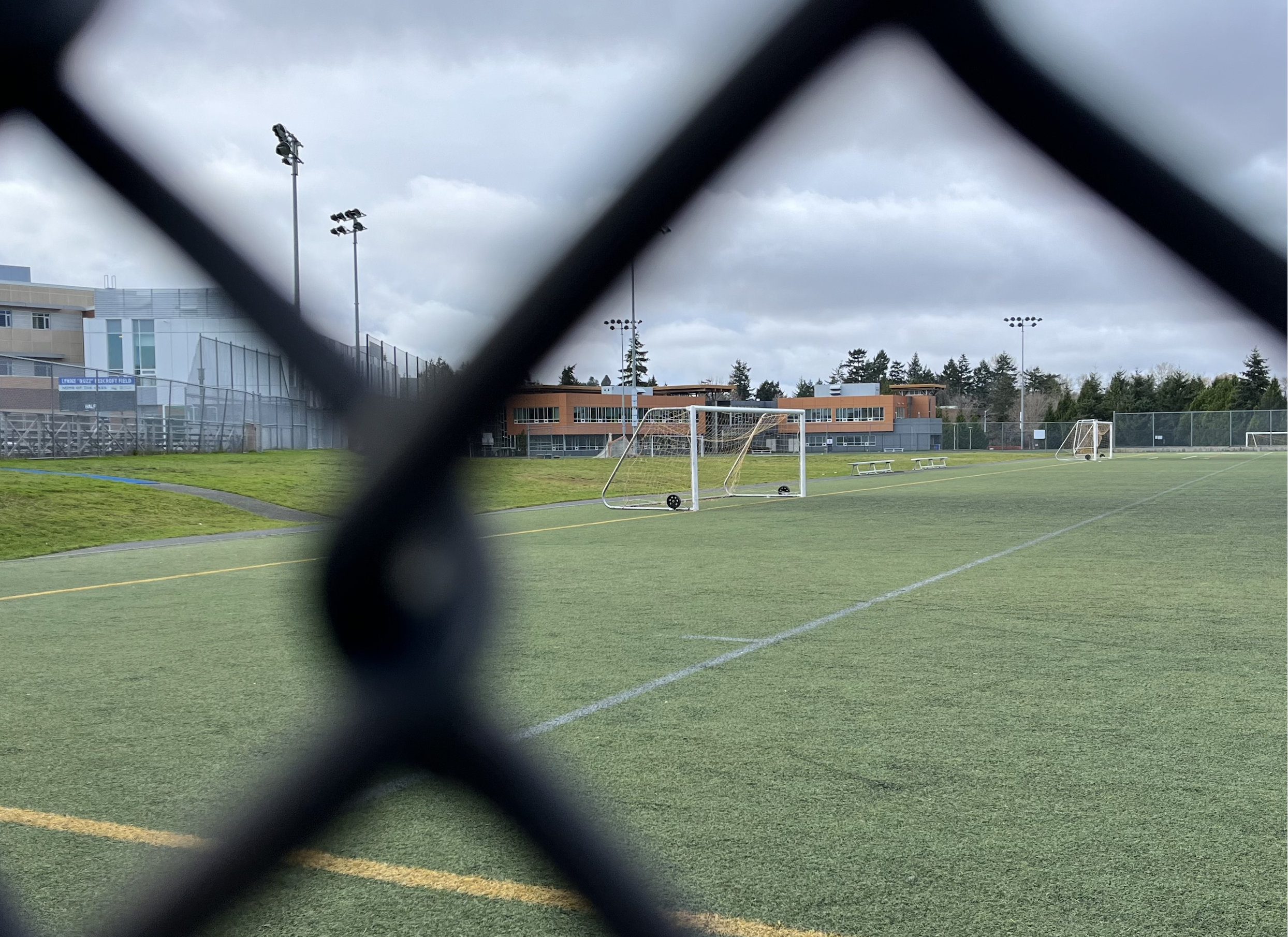Artificial turf fields are saving UVic money, but costing the environment

Photo by Sage Blackwell.
When it comes to facilities, the world of professional sports has had to walk a fine line — satisfying the needs of their athletes, the demands of the public, and the pockets of their executives and benefactors. However, in recent years, a new entity has begun asking for attention from sports: Mother Earth.
More than ever before, sports teams are being asked questions about their impact on the environment and how their facilities can best practice eco-friendliness and carbon neutrality. A notable example, and one that is as prescient to collegiate athletics as it is to pro sports, is the ongoing discussion between artificial turf and grass fields.
Back in July, the Vancouver Whitecaps were on the wrong side of headlines after it was reported that Wrexham AFC, the viral Welsh club owned by Ryan Reynolds, would withdraw from their scheduled exhibition game unless real grass was installed at BC Place.
A painstaking process followed, wherein the stadium was forced to import 30 trucks worth of grass for a single 90 minute match. A similar process will happen in 2026, when the FIFA World Cup comes to North America.
Much like BC Place, UVic’s recreational soccer and field hockey fields are artificial. And, much like the Whitecaps, the Vikes should be putting their use of the material under the microscope. Because, while artificial turf is often presumed to be more environmentally friendly than real grass, recent research has been showing that this may not be the case. In fact, it might be just the opposite.
“Were there a greenwashing hall of fame, this would be in it,” said Charles Miller, chair of the LA division of the Climate Reality Project, in an LA Times op-ed. “Artificial turf is bad for our ecosystems as well as our health.”
Miller, alongside his fellow turf detractors, cites multiple reasons for phasing out these synthetic surfaces.
First of all, grass and soil are natural carbon sinks. They take in greenhouse gasses and either convert them or break them down. However, since artificial turf cannot be installed on top of existing grass, those carbon sinks must be ripped up and replaced, usually by sand or finely crushed rock. Not only does this eliminate a useful source for reducing greenhouse gasses, but it actively releases stored carbon into the atmosphere.
Typically made from either nylon, polypropylene or polyethylene, artificial turf is, by definition, a single use plastic. Not only that, but it is filled with microplastics and PFAs, or “forever chemicals,” which make it extremely difficult or impossible to recycle.
A chemical analysis done by Yale University found 96 different chemicals — ten of them carcinogens — in artificial turf. Combine that with new studies which say athletes have an upwards of 16 per cent higher chance of injury on artificial turf compared to grass, and it is clear that turf poses a real health risk to players.
To make matters worse, the supposed benefit of artificial turf — reduced water usage — may not be accurate. If you’ve ever passed by an artificial turf field, you may have noticed it being sprayed down with water.
This is because turf is impermeable, meaning that sweat, spit, blood, and animal feces all stay on the surface, whereas with grass they would be absorbed. On top of frequent cleaning, artificial turf must also be watered for cooling purposes, as on hot days it can reach higher temperatures than concrete or asphalt can.
Some artificial turfs, like that at the Lynne “Buzz” Beecroft Field, where the Vikes women’s field hockey team plays, take this usage a step further. Buzz Field uses what is known as “water-based turf,” which requires “integrated irrigation systems and water cannons or sprinklers to apply the water ‘infill’ layer,” according to Sport and Play. This water layer reduces friction and improves ball speed, but must be frequently reapplied.
Greenfields, an internationally recognized turf company who supplied the fields for the 2014 Field Hockey World Cup, reports that approximately 6 000 litres of water is used each match to irrigate the water-based turf. That’s equivalent to the drinking water of a three person household over a six and a half year span.
There are, of course, legitimate reasons for the use of artificial grass. It’s cheaper, with one study — which was organized by a turf supplier, and thus should be subject to some scrutiny — estimating it costs around four times less over a ten year span. Turf is also easier to maintain and oftentimes more aesthetically pleasing.
The University of Guelph, in conjunction with Canadian Premiere League team Toronto FC, has recently been working with hybrid grass, which sews about five per cent artificial turf into real lawn grass. This method is used by the top football clubs in Europe, and has now been permanently adapted to BMO Field in Toronto.
Moreover, several of the largest and most well-respected American athletics programs — Alabama, Iowa State, and Georgia — continue to use exclusively real grass. In the case of field hockey, the IHF has recently begun encouraging the development and use of non-irrigated dry turfs, with the ultimate goal of completely replacing the 2 000 plus water-based turfs used globally.
Despite this, the vast majority of varsity sports fields in Canada are still artificial turf. Whether it’s Thunderbird Park in Vancouver, Foote Field in Edmonton, or the CARSA fields here at UVic, artificial turf has become the norm in the North.
But it may be time to start looking hard at whether a surface which is worse for athletes, worse for the community, and worse on the environment is really still our best option.








